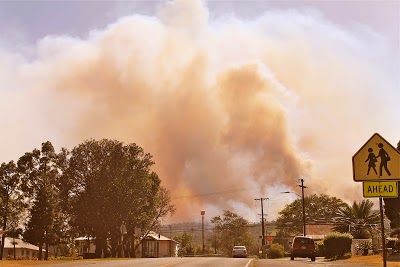 |
| An eruptive vent with lava fountaining during the latest Kīlauea eruption. See more below. USGS Photo |
REDUCING FIRE RISK AND RESTORING LANDSCAPES are the focus of three new grants announced Tuesday by the state Department of Land & Natural Resources. The application period is open and DLNR Division of Forestry and Wildlife. The opportunities include Landscape Scale Restoration grants, Community Wildfire Defense grants, and Wildland-Urban Interface grants. All three are funded by the US Forest Service.
Restore and Maintain Landscapes so that landscapes across all jurisdictions are resilient to fire-related
disturbances, in accordance with management objectives.
Create Fire-Adapted Communities so that human populations and infrastructure can withstand a wildfire without loss of life and property.
Improve Wildfire Response so that all jurisdictions participate in making and implementing safe, effective, efficient risk-based wildfire management decisions.
Full details are available at the Hawaiʻi Awards & Notices Data System. Applicants can contact Michael Walker at michael.j.walker@hawaii.gov for more information.
Wildland-Urban Interface Grant applications are due on Jan. 5, 2024. Funds will be used to mitigate risk from wildland fire within the Wildland-Urban Interface (WUI). They are available and awarded annually through a competitive process with emphasis on:
 |
| A sign melted along Hwy 11 during one of many fires that came into Pāhala over the last 15 years. Photo by Ralph Gaston |
Create Fire-Adapted Communities so that human populations and infrastructure can withstand a wildfire without loss of life and property.
Improve Wildfire Response so that all jurisdictions participate in making and implementing safe, effective, efficient risk-based wildfire management decisions.
Full details are available at the Hawaiʻi Awards & Notices Data System. Applicants can contact Michael Walker at michael.j.walker@hawaii.gov for more information.
Wildland-Urban Interface Grant applications are due on Jan. 5, 2024. Funds will be used to mitigate risk from wildland fire within the Wildland-Urban Interface (WUI). They are available and awarded annually through a competitive process with emphasis on:
- Hazard fuel reduction in the WUI.
- Information and education.
- Assessment and planning.
- Monitoring through community and landowner action.
Full details are available at the Hawaiʻi Awards & Notices Data System. Note that this grant opportunity is listed in the same Request for Interest as the Landscape Scale Restoration Grants. Applications should be emailed to Michael Walker (michael.j.walker@hawaii.gov), DLNR State Fire Protection Forester, using subject header “WUI Request for Interest.”
 |
| A wildfire raged through lands at South Point, Kalae. New grants are available for communities to restore landscape and help prevent wildfires. Photo by Isaac Davis |
Landscape Scale Restoration Grant applications are due at noon on Oct 16. The funding will be used to address priority landscapes and/or issues identified in the Hawaiʻi Forest Action Plan and encourage collaborative, science-based restoration projects that encompass a diversity of ownerships at a scale that can address the restoration objectives identified in the project. A project proposal must be designed to achieve one or more of the following Landscape Objectives:
Reduce the risk of uncharacteristic wildfires.
The flag-raising is a powerful symbol of the enduring ties and shared histories between Filipinos and Americans. Filipino-American History Month is celebrated every October in the United States to recognize the significant roles that Filipino-Americans have played throughout US history, notes the statement from the County of Hawai‘i. "All are encouraged to attend the ceremony and join in the celebrations that pay homage to the shared cultural heritage and the myriad of achievements of the Filipino-American community."
The Filipino community thrives in Kaʻū, and is integral in building the famous Kaʻū Coffee industry and setting an example of plantation workers transitioning from working in the sugar fields and factories to becoming Kaʻū Coffee farm owners and independent entrepreneurs. The sugar industry in Kaʻū shut down in 1996 and workers immediately started growing their own coffee.
Filipino song, dance and food are other contributions to Kaʻū culture. One Filipino song recognizes the early Filipino immigrants, the Sakadas, who came by ship to work in the plantations. It urges all Filipinos to understand their history. In Ilocano, the lyrics are “Okradek ti pakasaritaa. Daguiti Pilipino iti Hawai‘i, Tapno maamuan tay it gapwanan. Daguiti ammatay a namauangayan.” It means, “Let me present the story of the Filipinos in Hawai‘i so we shall know the sacrifices and accomplishments of our fathers who came to Hawai‘i before us. Do you recognize and appreciate your roots? If your life is better and more prosperous now, you have to realize that you owe this to the Sakadas!”
Filipinos represent the most populous ethnic group in the state. During the 1930’s, Filipinos were 70 percent of the plantation labor force. By 1946, 100,000 Sakadas had reached Hawai‘i's shores.
Kaʻū Filipinos have formed Filipino Clubs, represented their culture in parades and celebrated Sakada Days over the years.
Improve fish and wildlife habitats, including habitats for threatened and endangered species.
Maintain or improve water quality and watershed functions.
Mitigate invasive species, insect infestation, and disease.
Improve important forest ecosystems; and
Measure ecological and economic benefits including air quality and soil quality and productivity.
Ineligible activities include but are not limited to purchasing land, purchasing technical equipment greater than $5,000 without prior approval by USFS, work on federal land, construction (e.g., new buildings or roads), and research-related activities.
Full details are available at the Hawaiʻi Awards & Notices Data System. Note that this grant opportunity is listed in the same Request for Interest as the Wildland-Urban Interface Grants. Applications should be emailed to Tanya Rubenstein (tanya.rubenstein@hawaii.gov), DLNR Cooperative Resource Management Forester, using the subject header “LSR Request for Interest.”
Maintain or improve water quality and watershed functions.
Mitigate invasive species, insect infestation, and disease.
Improve important forest ecosystems; and
Measure ecological and economic benefits including air quality and soil quality and productivity.
Ineligible activities include but are not limited to purchasing land, purchasing technical equipment greater than $5,000 without prior approval by USFS, work on federal land, construction (e.g., new buildings or roads), and research-related activities.
Full details are available at the Hawaiʻi Awards & Notices Data System. Note that this grant opportunity is listed in the same Request for Interest as the Wildland-Urban Interface Grants. Applications should be emailed to Tanya Rubenstein (tanya.rubenstein@hawaii.gov), DLNR Cooperative Resource Management Forester, using the subject header “LSR Request for Interest.”
To read comments, add your own, and like this story, see facebook.com/kaucalendar. See latest print edition at kaucalendar.com, in the mail and on stands.
 |
| A group of visitors look into the crater. See https://www.nps.gov/.../september-2023-summit-eruption.htm. NPS photo |
A VIRTUAL LAVA EXPERIENCE DOCUMENTING THE LATEST KĪLAUEA ERUPTION has been released by the National Park Service. The online documentary presents "video chronology, breathtaking pictures, and informative U.S. Geological Survey maps," says an NPS statement.
Visit the September 2023 Summit Eruption webpage on the park website: https://www.nps.gov/.../september-2023-summit-eruption.htm.
Visit the September 2023 Summit Eruption webpage on the park website: https://www.nps.gov/.../september-2023-summit-eruption.htm.
To read comments, add your own, and like this story, see facebook.com/kaucalendar. See latest print edition at kaucalendar.com, in the mail and on stands.
OCTOBER IS FILIPINO-AMERICAN HISTORY MONTH and the Philippine flag will be prominently displayed at the county building in Hilo and West Hawaiʻi Civic Center in Kona from Oct. 2-6. Mayor Mitch Roth invites members of the Filipino community and the general public to join in a special flag-raising ceremony on Monday, Oct. 2. The event will commence at 7:30 a.m. at the county building in Hilo.
"This gesture signifies the rich history and invaluable contributions of the Filipino-American community to our county and the nation at large," said the Mayor. "It's an opportunity for us to come together in unity and appreciation."
"This gesture signifies the rich history and invaluable contributions of the Filipino-American community to our county and the nation at large," said the Mayor. "It's an opportunity for us to come together in unity and appreciation."
Jane Clement, executive assistant to the Mayor and a prominent Filipino community leader, added, "Seeing the Philippine flag raised is a testament to the enduring strength and resilience of the Filipino-American community. It's a moment of pride for all of us, reminding us of our roots and the bridges we've built together."
 |
| The clicking of the bamboo sticks is traditional in Filipino dance in Pāhala. Photo by Julia Neal |
The Filipino community thrives in Kaʻū, and is integral in building the famous Kaʻū Coffee industry and setting an example of plantation workers transitioning from working in the sugar fields and factories to becoming Kaʻū Coffee farm owners and independent entrepreneurs. The sugar industry in Kaʻū shut down in 1996 and workers immediately started growing their own coffee.
Contributions by Filipinos in Kaʻū also include military service and sacrifice during World War II, to the Korean, Viet Nam and Middle East wars fought by the U.S. Filipino World War II veterans received the Congressional Gold Medal.
Filipinos are also heavily involved in health care and culinary careers in Kaʻū.
 |
| Filipino traditional dress shown at a Sakada day in Pāhala. Photo by Julia Neal |
Filipinos represent the most populous ethnic group in the state. During the 1930’s, Filipinos were 70 percent of the plantation labor force. By 1946, 100,000 Sakadas had reached Hawai‘i's shores.
Kaʻū Filipinos have formed Filipino Clubs, represented their culture in parades and celebrated Sakada Days over the years.
To read comments, add your own, and like this story, see facebook.com/kaucalendar. See latest print edition at kaucalendar.com, in the mail and on stands.


-1.png)

-1.jpg)







